MLC301 Principles of Taxation Law: Income Assessment Analysis
VerifiedAdded on 2023/06/12
|10
|2146
|50
Homework Assignment
AI Summary
This assignment delves into various aspects of Australian taxation law, focusing on the concepts of assessable income, ordinary income, and statutory income. It analyzes scenarios involving gifts, annuity payments, dividends, rental income, and compensation receipts to determine their tax implications under the Income Tax Assessment Act 1997 (ITAA 1997) and relevant case law. The assignment addresses issues such as whether a redeemable gift voucher constitutes taxable income, the taxability of retention payments, and the treatment of income derived from business activities like land development and the sale of liquor. It also examines the conditions under which compensation payments are considered income and explores the definition of 'business' under taxation rulings. Case references like Scott v Federal Commissioner of Taxation, Dixon v Federal Commissioner of Taxation, and Federal Coke Co Pty Ltd v Federal Commissioner of Taxation are used to support the analysis and conclusions.
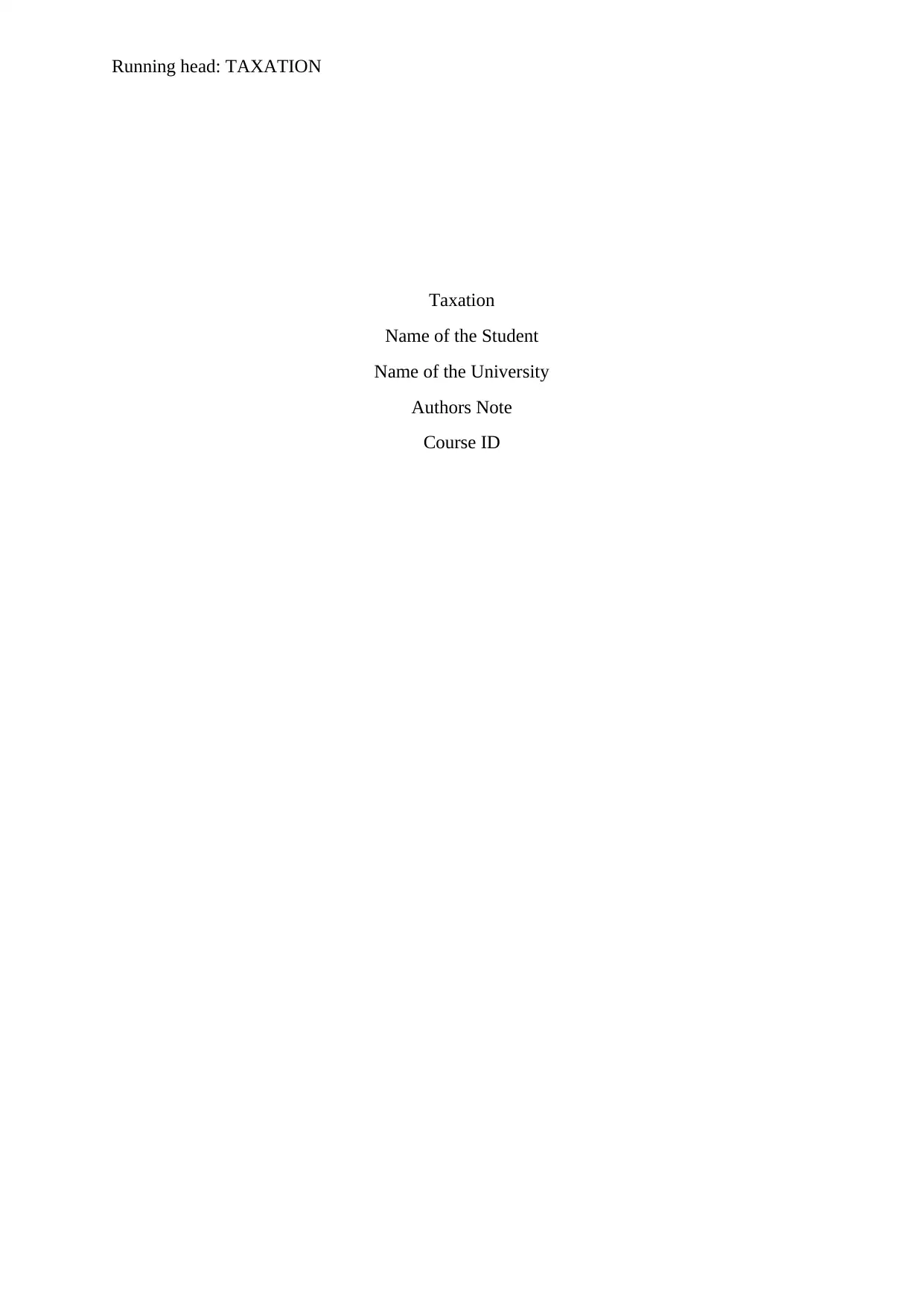
Running head: TAXATION
Taxation
Name of the Student
Name of the University
Authors Note
Course ID
Taxation
Name of the Student
Name of the University
Authors Note
Course ID
Paraphrase This Document
Need a fresh take? Get an instant paraphrase of this document with our AI Paraphraser
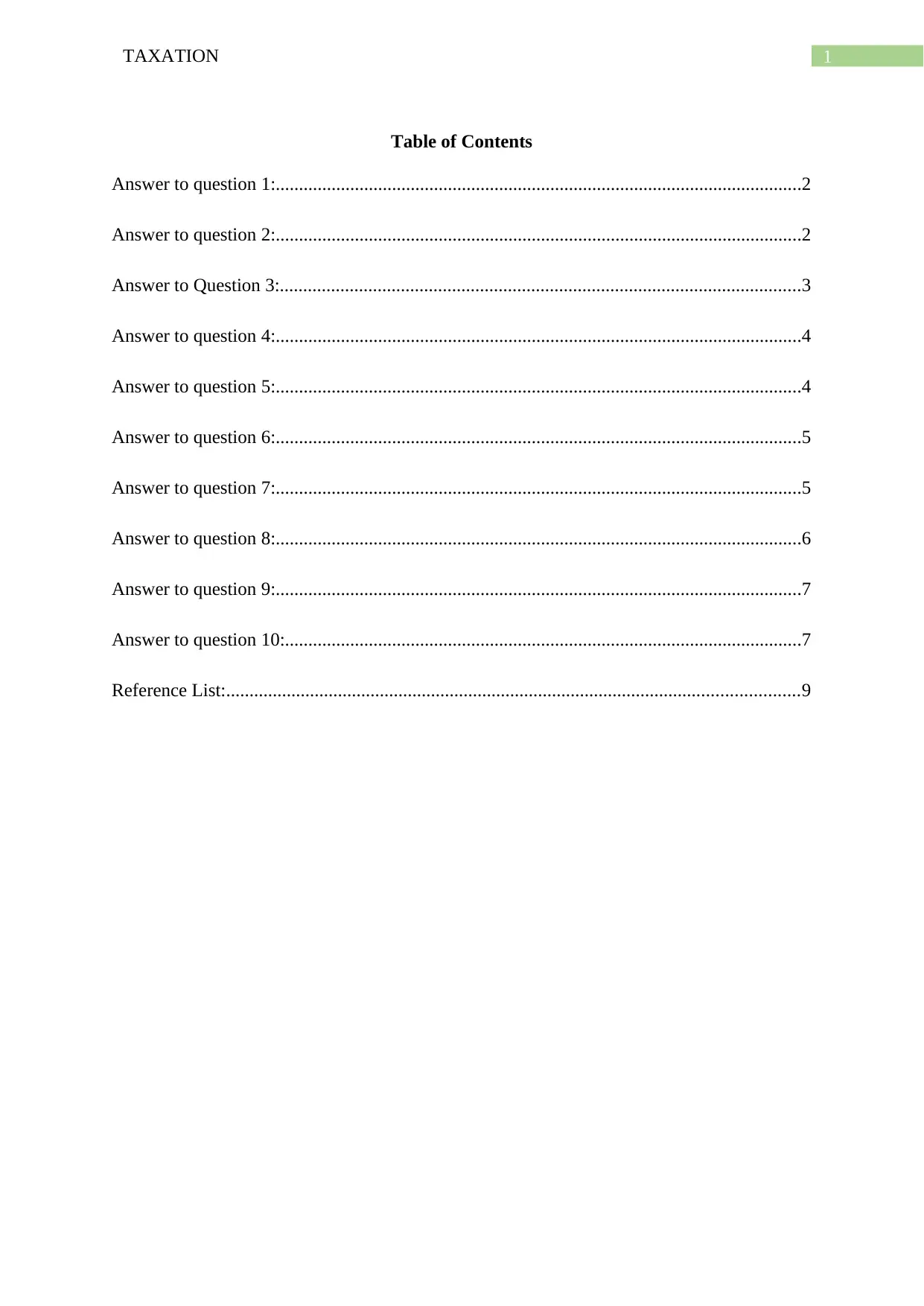
1TAXATION
Table of Contents
Answer to question 1:.................................................................................................................2
Answer to question 2:.................................................................................................................2
Answer to Question 3:................................................................................................................3
Answer to question 4:.................................................................................................................4
Answer to question 5:.................................................................................................................4
Answer to question 6:.................................................................................................................5
Answer to question 7:.................................................................................................................5
Answer to question 8:.................................................................................................................6
Answer to question 9:.................................................................................................................7
Answer to question 10:...............................................................................................................7
Reference List:...........................................................................................................................9
Table of Contents
Answer to question 1:.................................................................................................................2
Answer to question 2:.................................................................................................................2
Answer to Question 3:................................................................................................................3
Answer to question 4:.................................................................................................................4
Answer to question 5:.................................................................................................................4
Answer to question 6:.................................................................................................................5
Answer to question 7:.................................................................................................................5
Answer to question 8:.................................................................................................................6
Answer to question 9:.................................................................................................................7
Answer to question 10:...............................................................................................................7
Reference List:...........................................................................................................................9
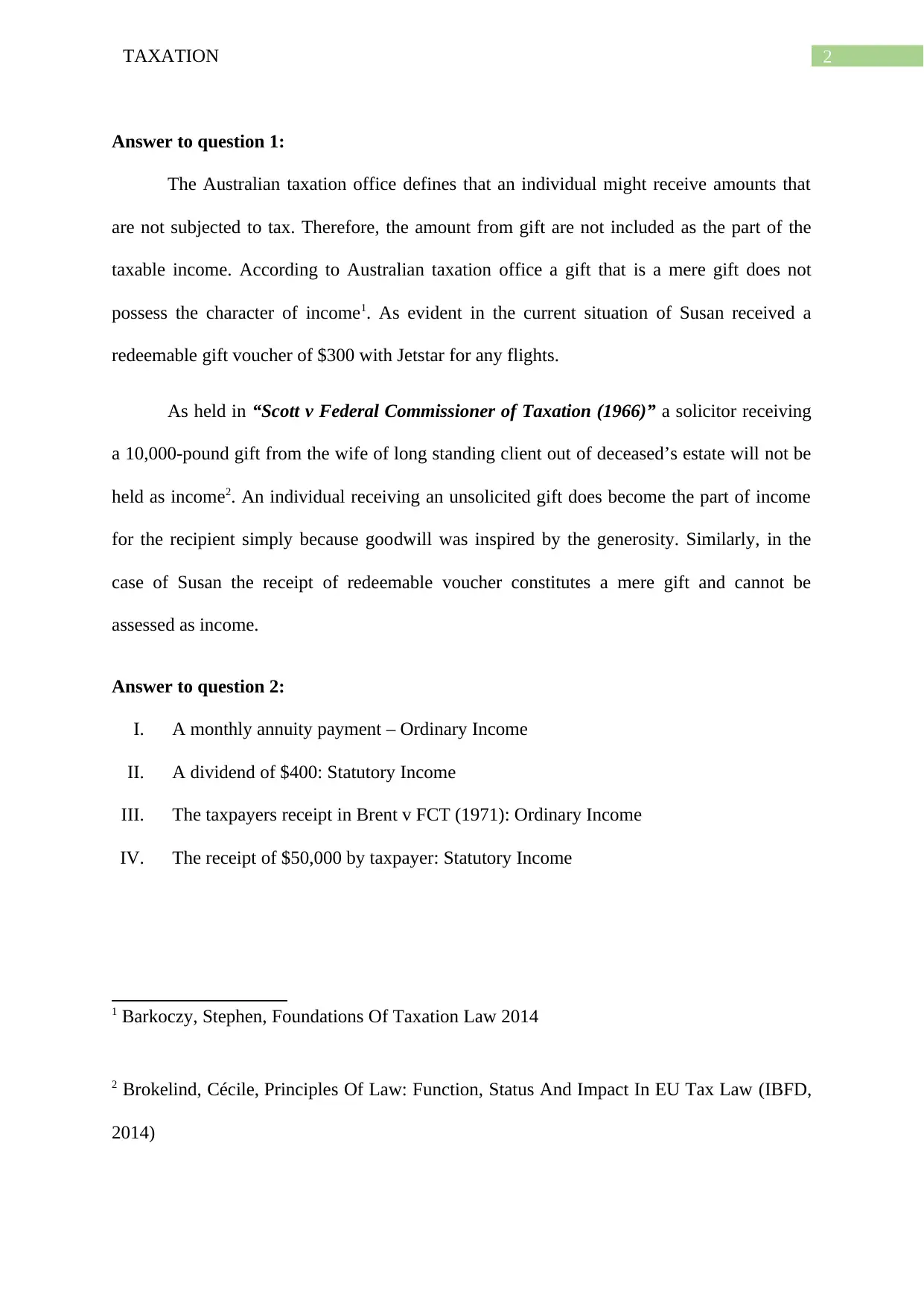
2TAXATION
Answer to question 1:
The Australian taxation office defines that an individual might receive amounts that
are not subjected to tax. Therefore, the amount from gift are not included as the part of the
taxable income. According to Australian taxation office a gift that is a mere gift does not
possess the character of income1. As evident in the current situation of Susan received a
redeemable gift voucher of $300 with Jetstar for any flights.
As held in “Scott v Federal Commissioner of Taxation (1966)” a solicitor receiving
a 10,000-pound gift from the wife of long standing client out of deceased’s estate will not be
held as income2. An individual receiving an unsolicited gift does become the part of income
for the recipient simply because goodwill was inspired by the generosity. Similarly, in the
case of Susan the receipt of redeemable voucher constitutes a mere gift and cannot be
assessed as income.
Answer to question 2:
I. A monthly annuity payment – Ordinary Income
II. A dividend of $400: Statutory Income
III. The taxpayers receipt in Brent v FCT (1971): Ordinary Income
IV. The receipt of $50,000 by taxpayer: Statutory Income
1 Barkoczy, Stephen, Foundations Of Taxation Law 2014
2 Brokelind, Cécile, Principles Of Law: Function, Status And Impact In EU Tax Law (IBFD,
2014)
Answer to question 1:
The Australian taxation office defines that an individual might receive amounts that
are not subjected to tax. Therefore, the amount from gift are not included as the part of the
taxable income. According to Australian taxation office a gift that is a mere gift does not
possess the character of income1. As evident in the current situation of Susan received a
redeemable gift voucher of $300 with Jetstar for any flights.
As held in “Scott v Federal Commissioner of Taxation (1966)” a solicitor receiving
a 10,000-pound gift from the wife of long standing client out of deceased’s estate will not be
held as income2. An individual receiving an unsolicited gift does become the part of income
for the recipient simply because goodwill was inspired by the generosity. Similarly, in the
case of Susan the receipt of redeemable voucher constitutes a mere gift and cannot be
assessed as income.
Answer to question 2:
I. A monthly annuity payment – Ordinary Income
II. A dividend of $400: Statutory Income
III. The taxpayers receipt in Brent v FCT (1971): Ordinary Income
IV. The receipt of $50,000 by taxpayer: Statutory Income
1 Barkoczy, Stephen, Foundations Of Taxation Law 2014
2 Brokelind, Cécile, Principles Of Law: Function, Status And Impact In EU Tax Law (IBFD,
2014)
⊘ This is a preview!⊘
Do you want full access?
Subscribe today to unlock all pages.

Trusted by 1+ million students worldwide
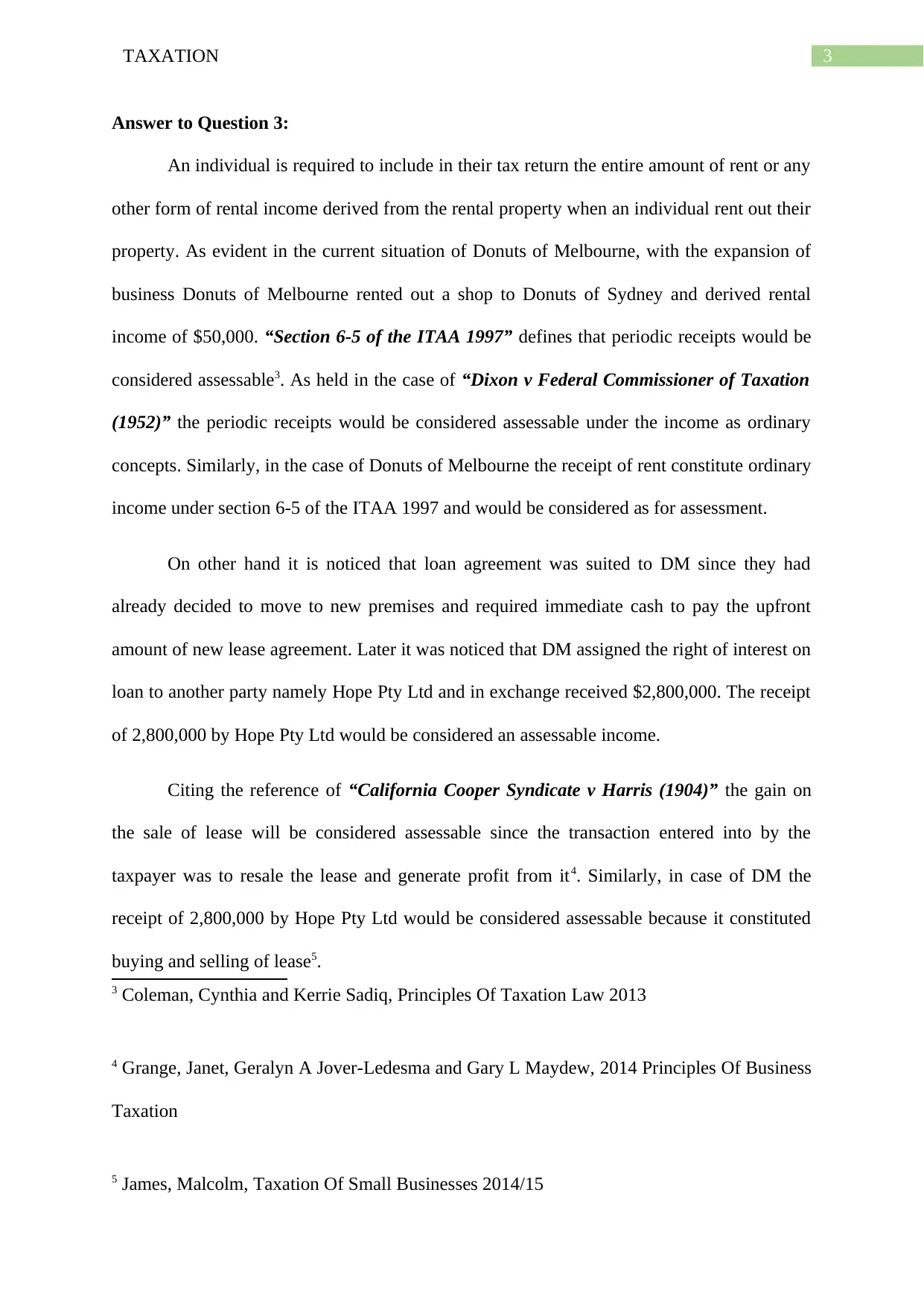
3TAXATION
Answer to Question 3:
An individual is required to include in their tax return the entire amount of rent or any
other form of rental income derived from the rental property when an individual rent out their
property. As evident in the current situation of Donuts of Melbourne, with the expansion of
business Donuts of Melbourne rented out a shop to Donuts of Sydney and derived rental
income of $50,000. “Section 6-5 of the ITAA 1997” defines that periodic receipts would be
considered assessable3. As held in the case of “Dixon v Federal Commissioner of Taxation
(1952)” the periodic receipts would be considered assessable under the income as ordinary
concepts. Similarly, in the case of Donuts of Melbourne the receipt of rent constitute ordinary
income under section 6-5 of the ITAA 1997 and would be considered as for assessment.
On other hand it is noticed that loan agreement was suited to DM since they had
already decided to move to new premises and required immediate cash to pay the upfront
amount of new lease agreement. Later it was noticed that DM assigned the right of interest on
loan to another party namely Hope Pty Ltd and in exchange received $2,800,000. The receipt
of 2,800,000 by Hope Pty Ltd would be considered an assessable income.
Citing the reference of “California Cooper Syndicate v Harris (1904)” the gain on
the sale of lease will be considered assessable since the transaction entered into by the
taxpayer was to resale the lease and generate profit from it4. Similarly, in case of DM the
receipt of 2,800,000 by Hope Pty Ltd would be considered assessable because it constituted
buying and selling of lease5.
3 Coleman, Cynthia and Kerrie Sadiq, Principles Of Taxation Law 2013
4 Grange, Janet, Geralyn A Jover-Ledesma and Gary L Maydew, 2014 Principles Of Business
Taxation
5 James, Malcolm, Taxation Of Small Businesses 2014/15
Answer to Question 3:
An individual is required to include in their tax return the entire amount of rent or any
other form of rental income derived from the rental property when an individual rent out their
property. As evident in the current situation of Donuts of Melbourne, with the expansion of
business Donuts of Melbourne rented out a shop to Donuts of Sydney and derived rental
income of $50,000. “Section 6-5 of the ITAA 1997” defines that periodic receipts would be
considered assessable3. As held in the case of “Dixon v Federal Commissioner of Taxation
(1952)” the periodic receipts would be considered assessable under the income as ordinary
concepts. Similarly, in the case of Donuts of Melbourne the receipt of rent constitute ordinary
income under section 6-5 of the ITAA 1997 and would be considered as for assessment.
On other hand it is noticed that loan agreement was suited to DM since they had
already decided to move to new premises and required immediate cash to pay the upfront
amount of new lease agreement. Later it was noticed that DM assigned the right of interest on
loan to another party namely Hope Pty Ltd and in exchange received $2,800,000. The receipt
of 2,800,000 by Hope Pty Ltd would be considered an assessable income.
Citing the reference of “California Cooper Syndicate v Harris (1904)” the gain on
the sale of lease will be considered assessable since the transaction entered into by the
taxpayer was to resale the lease and generate profit from it4. Similarly, in case of DM the
receipt of 2,800,000 by Hope Pty Ltd would be considered assessable because it constituted
buying and selling of lease5.
3 Coleman, Cynthia and Kerrie Sadiq, Principles Of Taxation Law 2013
4 Grange, Janet, Geralyn A Jover-Ledesma and Gary L Maydew, 2014 Principles Of Business
Taxation
5 James, Malcolm, Taxation Of Small Businesses 2014/15
Paraphrase This Document
Need a fresh take? Get an instant paraphrase of this document with our AI Paraphraser
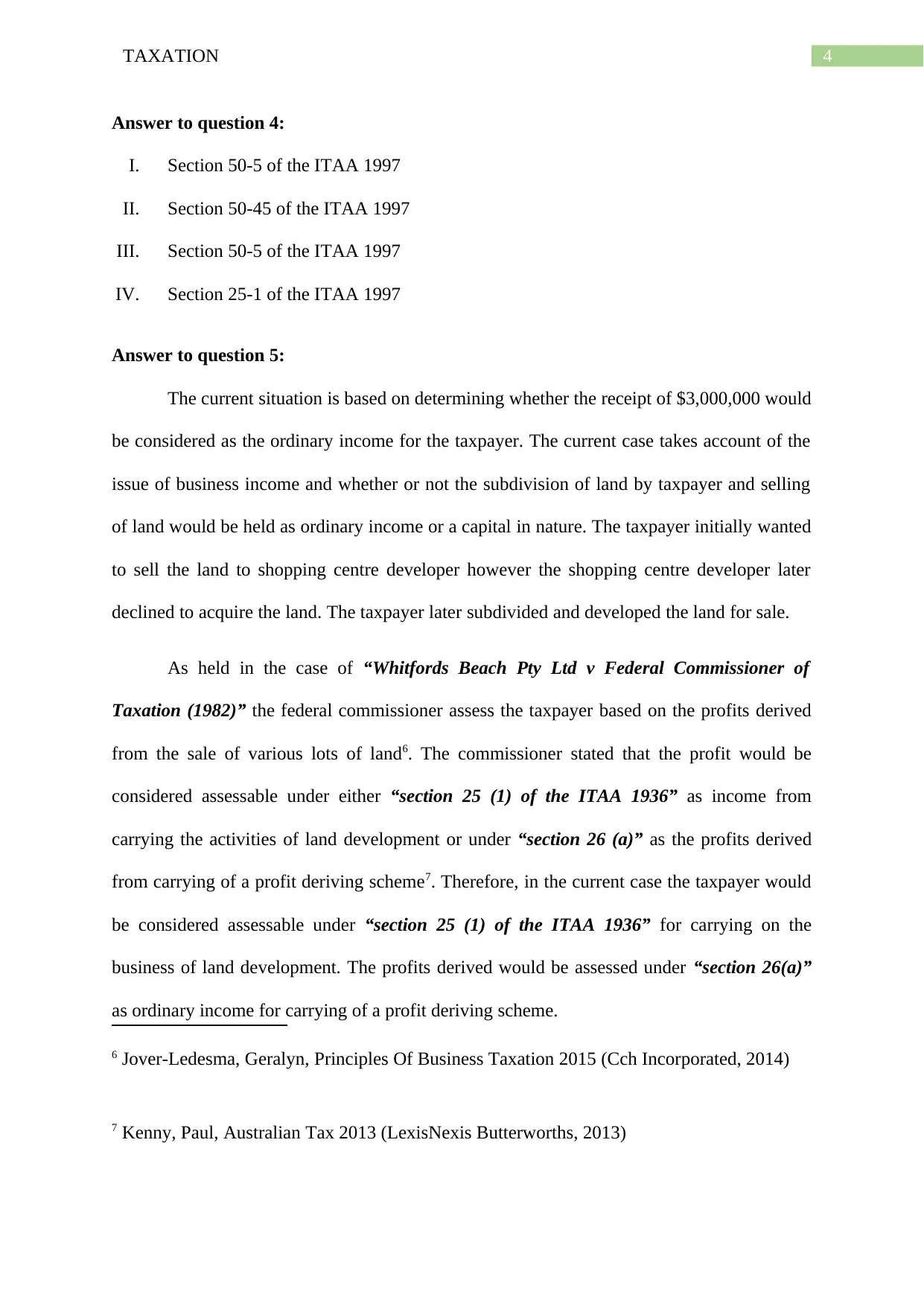
4TAXATION
Answer to question 4:
I. Section 50-5 of the ITAA 1997
II. Section 50-45 of the ITAA 1997
III. Section 50-5 of the ITAA 1997
IV. Section 25-1 of the ITAA 1997
Answer to question 5:
The current situation is based on determining whether the receipt of $3,000,000 would
be considered as the ordinary income for the taxpayer. The current case takes account of the
issue of business income and whether or not the subdivision of land by taxpayer and selling
of land would be held as ordinary income or a capital in nature. The taxpayer initially wanted
to sell the land to shopping centre developer however the shopping centre developer later
declined to acquire the land. The taxpayer later subdivided and developed the land for sale.
As held in the case of “Whitfords Beach Pty Ltd v Federal Commissioner of
Taxation (1982)” the federal commissioner assess the taxpayer based on the profits derived
from the sale of various lots of land6. The commissioner stated that the profit would be
considered assessable under either “section 25 (1) of the ITAA 1936” as income from
carrying the activities of land development or under “section 26 (a)” as the profits derived
from carrying of a profit deriving scheme7. Therefore, in the current case the taxpayer would
be considered assessable under “section 25 (1) of the ITAA 1936” for carrying on the
business of land development. The profits derived would be assessed under “section 26(a)”
as ordinary income for carrying of a profit deriving scheme.
6 Jover-Ledesma, Geralyn, Principles Of Business Taxation 2015 (Cch Incorporated, 2014)
7 Kenny, Paul, Australian Tax 2013 (LexisNexis Butterworths, 2013)
Answer to question 4:
I. Section 50-5 of the ITAA 1997
II. Section 50-45 of the ITAA 1997
III. Section 50-5 of the ITAA 1997
IV. Section 25-1 of the ITAA 1997
Answer to question 5:
The current situation is based on determining whether the receipt of $3,000,000 would
be considered as the ordinary income for the taxpayer. The current case takes account of the
issue of business income and whether or not the subdivision of land by taxpayer and selling
of land would be held as ordinary income or a capital in nature. The taxpayer initially wanted
to sell the land to shopping centre developer however the shopping centre developer later
declined to acquire the land. The taxpayer later subdivided and developed the land for sale.
As held in the case of “Whitfords Beach Pty Ltd v Federal Commissioner of
Taxation (1982)” the federal commissioner assess the taxpayer based on the profits derived
from the sale of various lots of land6. The commissioner stated that the profit would be
considered assessable under either “section 25 (1) of the ITAA 1936” as income from
carrying the activities of land development or under “section 26 (a)” as the profits derived
from carrying of a profit deriving scheme7. Therefore, in the current case the taxpayer would
be considered assessable under “section 25 (1) of the ITAA 1936” for carrying on the
business of land development. The profits derived would be assessed under “section 26(a)”
as ordinary income for carrying of a profit deriving scheme.
6 Jover-Ledesma, Geralyn, Principles Of Business Taxation 2015 (Cch Incorporated, 2014)
7 Kenny, Paul, Australian Tax 2013 (LexisNexis Butterworths, 2013)
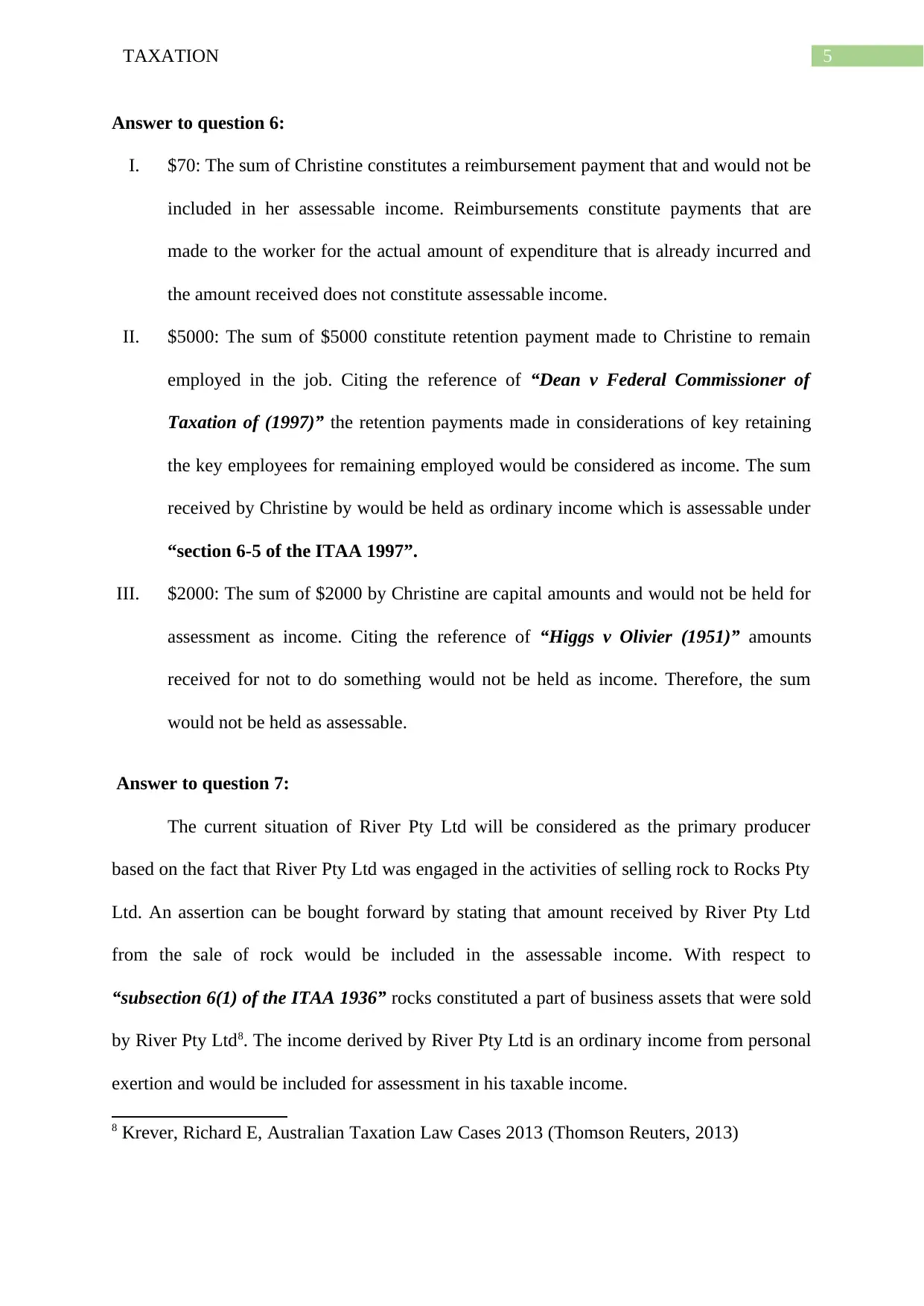
5TAXATION
Answer to question 6:
I. $70: The sum of Christine constitutes a reimbursement payment that and would not be
included in her assessable income. Reimbursements constitute payments that are
made to the worker for the actual amount of expenditure that is already incurred and
the amount received does not constitute assessable income.
II. $5000: The sum of $5000 constitute retention payment made to Christine to remain
employed in the job. Citing the reference of “Dean v Federal Commissioner of
Taxation of (1997)” the retention payments made in considerations of key retaining
the key employees for remaining employed would be considered as income. The sum
received by Christine by would be held as ordinary income which is assessable under
“section 6-5 of the ITAA 1997”.
III. $2000: The sum of $2000 by Christine are capital amounts and would not be held for
assessment as income. Citing the reference of “Higgs v Olivier (1951)” amounts
received for not to do something would not be held as income. Therefore, the sum
would not be held as assessable.
Answer to question 7:
The current situation of River Pty Ltd will be considered as the primary producer
based on the fact that River Pty Ltd was engaged in the activities of selling rock to Rocks Pty
Ltd. An assertion can be bought forward by stating that amount received by River Pty Ltd
from the sale of rock would be included in the assessable income. With respect to
“subsection 6(1) of the ITAA 1936” rocks constituted a part of business assets that were sold
by River Pty Ltd8. The income derived by River Pty Ltd is an ordinary income from personal
exertion and would be included for assessment in his taxable income.
8 Krever, Richard E, Australian Taxation Law Cases 2013 (Thomson Reuters, 2013)
Answer to question 6:
I. $70: The sum of Christine constitutes a reimbursement payment that and would not be
included in her assessable income. Reimbursements constitute payments that are
made to the worker for the actual amount of expenditure that is already incurred and
the amount received does not constitute assessable income.
II. $5000: The sum of $5000 constitute retention payment made to Christine to remain
employed in the job. Citing the reference of “Dean v Federal Commissioner of
Taxation of (1997)” the retention payments made in considerations of key retaining
the key employees for remaining employed would be considered as income. The sum
received by Christine by would be held as ordinary income which is assessable under
“section 6-5 of the ITAA 1997”.
III. $2000: The sum of $2000 by Christine are capital amounts and would not be held for
assessment as income. Citing the reference of “Higgs v Olivier (1951)” amounts
received for not to do something would not be held as income. Therefore, the sum
would not be held as assessable.
Answer to question 7:
The current situation of River Pty Ltd will be considered as the primary producer
based on the fact that River Pty Ltd was engaged in the activities of selling rock to Rocks Pty
Ltd. An assertion can be bought forward by stating that amount received by River Pty Ltd
from the sale of rock would be included in the assessable income. With respect to
“subsection 6(1) of the ITAA 1936” rocks constituted a part of business assets that were sold
by River Pty Ltd8. The income derived by River Pty Ltd is an ordinary income from personal
exertion and would be included for assessment in his taxable income.
8 Krever, Richard E, Australian Taxation Law Cases 2013 (Thomson Reuters, 2013)
⊘ This is a preview!⊘
Do you want full access?
Subscribe today to unlock all pages.

Trusted by 1+ million students worldwide
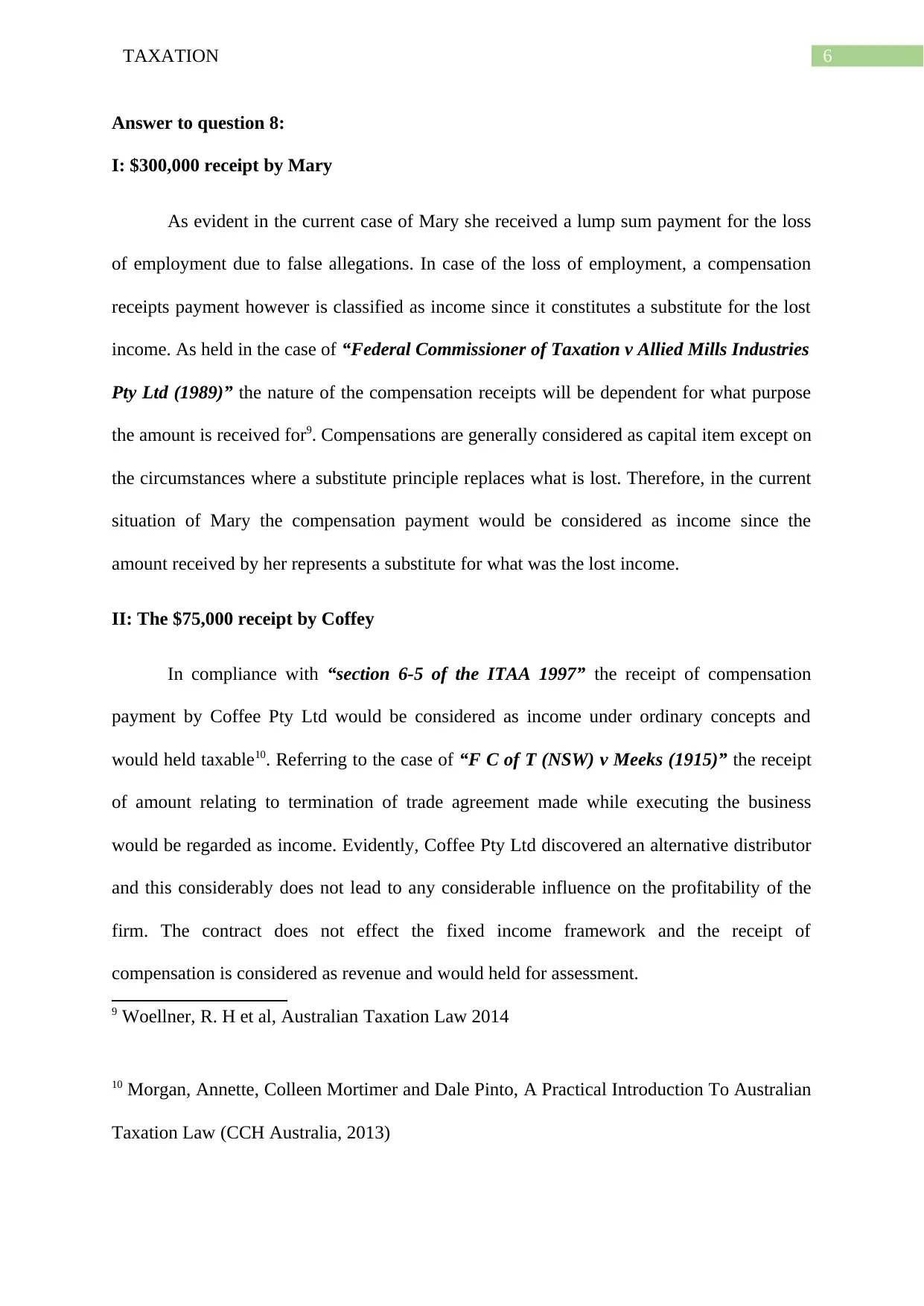
6TAXATION
Answer to question 8:
I: $300,000 receipt by Mary
As evident in the current case of Mary she received a lump sum payment for the loss
of employment due to false allegations. In case of the loss of employment, a compensation
receipts payment however is classified as income since it constitutes a substitute for the lost
income. As held in the case of “Federal Commissioner of Taxation v Allied Mills Industries
Pty Ltd (1989)” the nature of the compensation receipts will be dependent for what purpose
the amount is received for9. Compensations are generally considered as capital item except on
the circumstances where a substitute principle replaces what is lost. Therefore, in the current
situation of Mary the compensation payment would be considered as income since the
amount received by her represents a substitute for what was the lost income.
II: The $75,000 receipt by Coffey
In compliance with “section 6-5 of the ITAA 1997” the receipt of compensation
payment by Coffee Pty Ltd would be considered as income under ordinary concepts and
would held taxable10. Referring to the case of “F C of T (NSW) v Meeks (1915)” the receipt
of amount relating to termination of trade agreement made while executing the business
would be regarded as income. Evidently, Coffee Pty Ltd discovered an alternative distributor
and this considerably does not lead to any considerable influence on the profitability of the
firm. The contract does not effect the fixed income framework and the receipt of
compensation is considered as revenue and would held for assessment.
9 Woellner, R. H et al, Australian Taxation Law 2014
10 Morgan, Annette, Colleen Mortimer and Dale Pinto, A Practical Introduction To Australian
Taxation Law (CCH Australia, 2013)
Answer to question 8:
I: $300,000 receipt by Mary
As evident in the current case of Mary she received a lump sum payment for the loss
of employment due to false allegations. In case of the loss of employment, a compensation
receipts payment however is classified as income since it constitutes a substitute for the lost
income. As held in the case of “Federal Commissioner of Taxation v Allied Mills Industries
Pty Ltd (1989)” the nature of the compensation receipts will be dependent for what purpose
the amount is received for9. Compensations are generally considered as capital item except on
the circumstances where a substitute principle replaces what is lost. Therefore, in the current
situation of Mary the compensation payment would be considered as income since the
amount received by her represents a substitute for what was the lost income.
II: The $75,000 receipt by Coffey
In compliance with “section 6-5 of the ITAA 1997” the receipt of compensation
payment by Coffee Pty Ltd would be considered as income under ordinary concepts and
would held taxable10. Referring to the case of “F C of T (NSW) v Meeks (1915)” the receipt
of amount relating to termination of trade agreement made while executing the business
would be regarded as income. Evidently, Coffee Pty Ltd discovered an alternative distributor
and this considerably does not lead to any considerable influence on the profitability of the
firm. The contract does not effect the fixed income framework and the receipt of
compensation is considered as revenue and would held for assessment.
9 Woellner, R. H et al, Australian Taxation Law 2014
10 Morgan, Annette, Colleen Mortimer and Dale Pinto, A Practical Introduction To Australian
Taxation Law (CCH Australia, 2013)
Paraphrase This Document
Need a fresh take? Get an instant paraphrase of this document with our AI Paraphraser
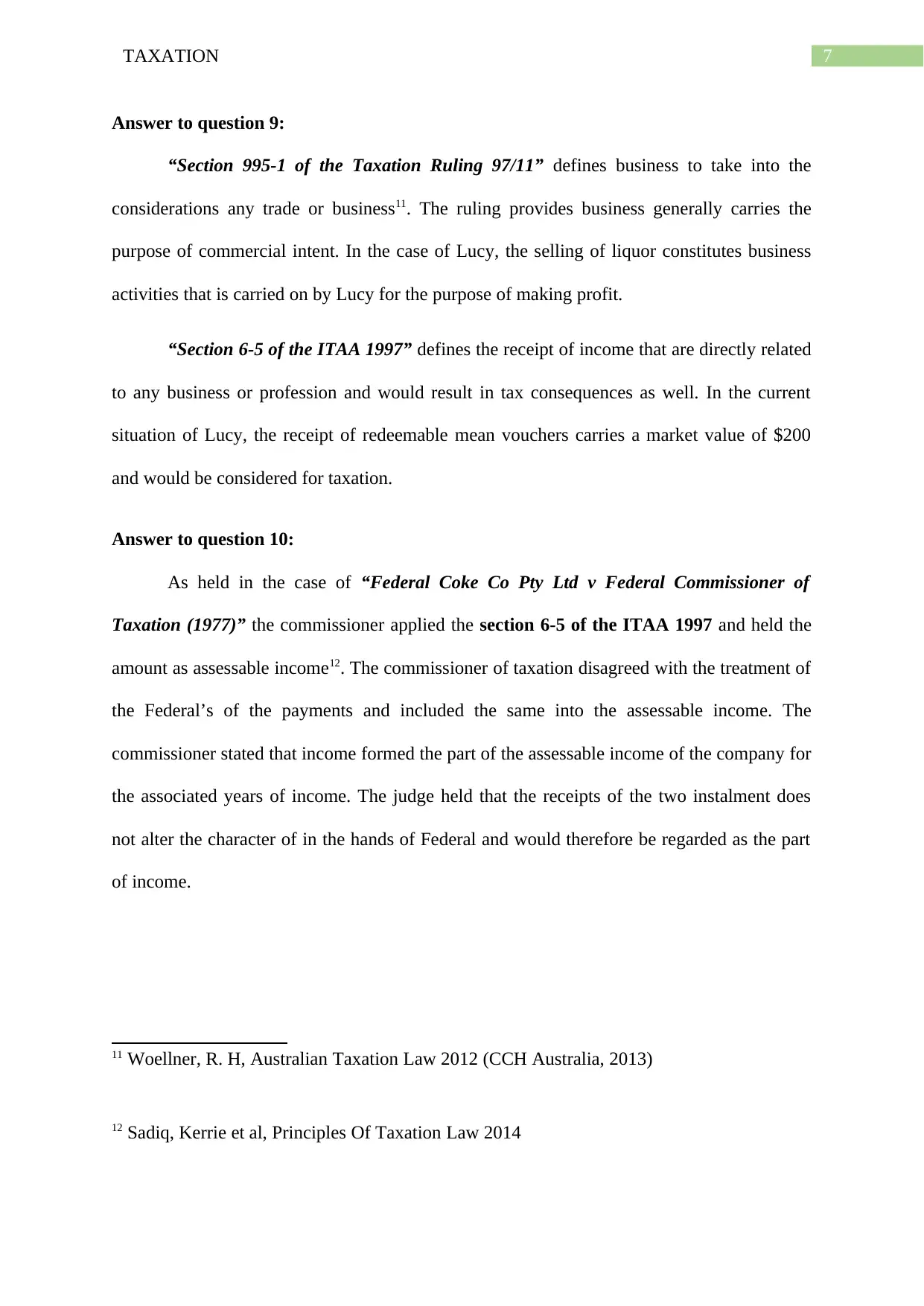
7TAXATION
Answer to question 9:
“Section 995-1 of the Taxation Ruling 97/11” defines business to take into the
considerations any trade or business11. The ruling provides business generally carries the
purpose of commercial intent. In the case of Lucy, the selling of liquor constitutes business
activities that is carried on by Lucy for the purpose of making profit.
“Section 6-5 of the ITAA 1997” defines the receipt of income that are directly related
to any business or profession and would result in tax consequences as well. In the current
situation of Lucy, the receipt of redeemable mean vouchers carries a market value of $200
and would be considered for taxation.
Answer to question 10:
As held in the case of “Federal Coke Co Pty Ltd v Federal Commissioner of
Taxation (1977)” the commissioner applied the section 6-5 of the ITAA 1997 and held the
amount as assessable income12. The commissioner of taxation disagreed with the treatment of
the Federal’s of the payments and included the same into the assessable income. The
commissioner stated that income formed the part of the assessable income of the company for
the associated years of income. The judge held that the receipts of the two instalment does
not alter the character of in the hands of Federal and would therefore be regarded as the part
of income.
11 Woellner, R. H, Australian Taxation Law 2012 (CCH Australia, 2013)
12 Sadiq, Kerrie et al, Principles Of Taxation Law 2014
Answer to question 9:
“Section 995-1 of the Taxation Ruling 97/11” defines business to take into the
considerations any trade or business11. The ruling provides business generally carries the
purpose of commercial intent. In the case of Lucy, the selling of liquor constitutes business
activities that is carried on by Lucy for the purpose of making profit.
“Section 6-5 of the ITAA 1997” defines the receipt of income that are directly related
to any business or profession and would result in tax consequences as well. In the current
situation of Lucy, the receipt of redeemable mean vouchers carries a market value of $200
and would be considered for taxation.
Answer to question 10:
As held in the case of “Federal Coke Co Pty Ltd v Federal Commissioner of
Taxation (1977)” the commissioner applied the section 6-5 of the ITAA 1997 and held the
amount as assessable income12. The commissioner of taxation disagreed with the treatment of
the Federal’s of the payments and included the same into the assessable income. The
commissioner stated that income formed the part of the assessable income of the company for
the associated years of income. The judge held that the receipts of the two instalment does
not alter the character of in the hands of Federal and would therefore be regarded as the part
of income.
11 Woellner, R. H, Australian Taxation Law 2012 (CCH Australia, 2013)
12 Sadiq, Kerrie et al, Principles Of Taxation Law 2014
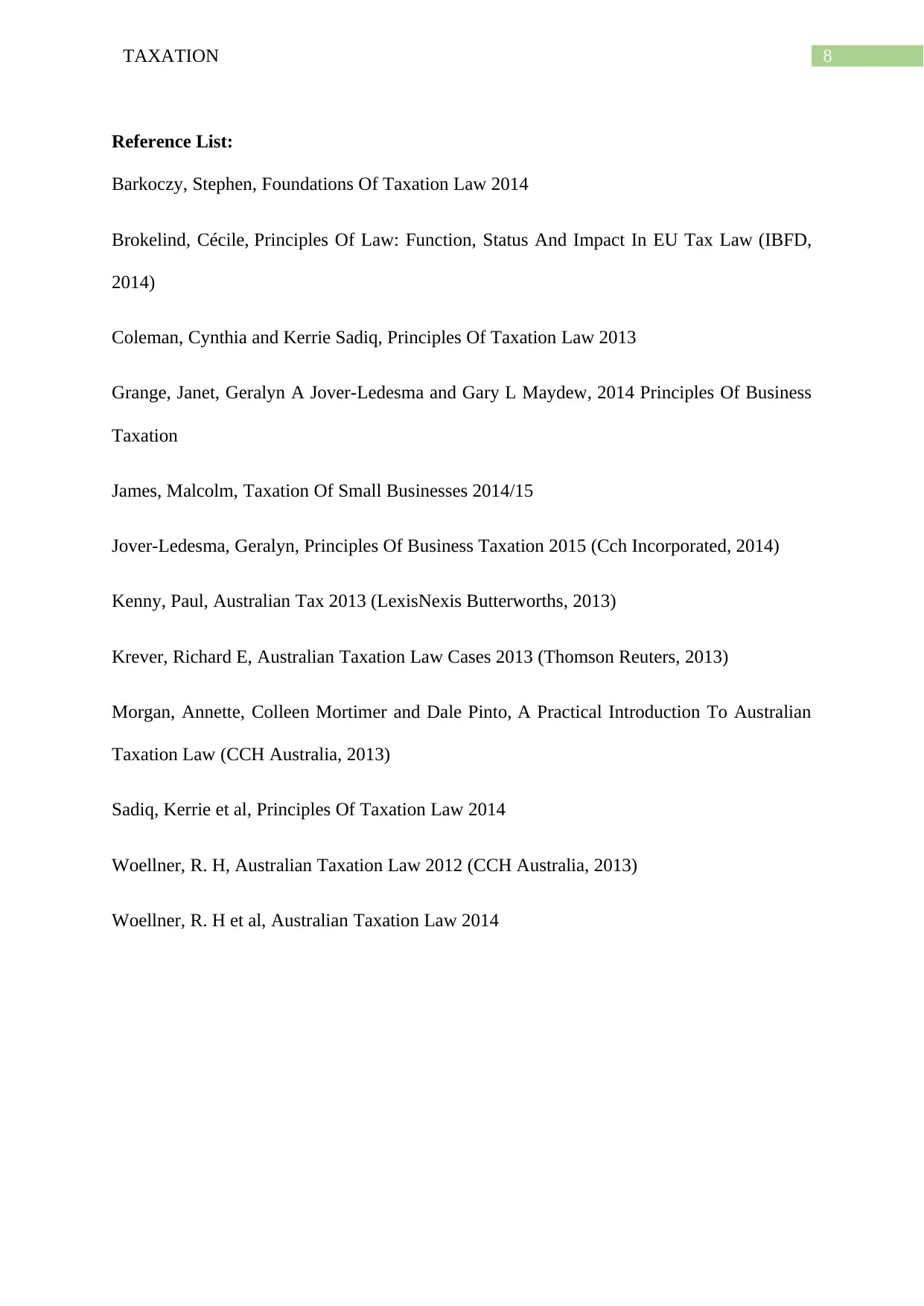
8TAXATION
Reference List:
Barkoczy, Stephen, Foundations Of Taxation Law 2014
Brokelind, Cécile, Principles Of Law: Function, Status And Impact In EU Tax Law (IBFD,
2014)
Coleman, Cynthia and Kerrie Sadiq, Principles Of Taxation Law 2013
Grange, Janet, Geralyn A Jover-Ledesma and Gary L Maydew, 2014 Principles Of Business
Taxation
James, Malcolm, Taxation Of Small Businesses 2014/15
Jover-Ledesma, Geralyn, Principles Of Business Taxation 2015 (Cch Incorporated, 2014)
Kenny, Paul, Australian Tax 2013 (LexisNexis Butterworths, 2013)
Krever, Richard E, Australian Taxation Law Cases 2013 (Thomson Reuters, 2013)
Morgan, Annette, Colleen Mortimer and Dale Pinto, A Practical Introduction To Australian
Taxation Law (CCH Australia, 2013)
Sadiq, Kerrie et al, Principles Of Taxation Law 2014
Woellner, R. H, Australian Taxation Law 2012 (CCH Australia, 2013)
Woellner, R. H et al, Australian Taxation Law 2014
Reference List:
Barkoczy, Stephen, Foundations Of Taxation Law 2014
Brokelind, Cécile, Principles Of Law: Function, Status And Impact In EU Tax Law (IBFD,
2014)
Coleman, Cynthia and Kerrie Sadiq, Principles Of Taxation Law 2013
Grange, Janet, Geralyn A Jover-Ledesma and Gary L Maydew, 2014 Principles Of Business
Taxation
James, Malcolm, Taxation Of Small Businesses 2014/15
Jover-Ledesma, Geralyn, Principles Of Business Taxation 2015 (Cch Incorporated, 2014)
Kenny, Paul, Australian Tax 2013 (LexisNexis Butterworths, 2013)
Krever, Richard E, Australian Taxation Law Cases 2013 (Thomson Reuters, 2013)
Morgan, Annette, Colleen Mortimer and Dale Pinto, A Practical Introduction To Australian
Taxation Law (CCH Australia, 2013)
Sadiq, Kerrie et al, Principles Of Taxation Law 2014
Woellner, R. H, Australian Taxation Law 2012 (CCH Australia, 2013)
Woellner, R. H et al, Australian Taxation Law 2014
⊘ This is a preview!⊘
Do you want full access?
Subscribe today to unlock all pages.

Trusted by 1+ million students worldwide

9TAXATION
1 out of 10
Related Documents
Your All-in-One AI-Powered Toolkit for Academic Success.
+13062052269
info@desklib.com
Available 24*7 on WhatsApp / Email
![[object Object]](/_next/static/media/star-bottom.7253800d.svg)
Unlock your academic potential
Copyright © 2020–2025 A2Z Services. All Rights Reserved. Developed and managed by ZUCOL.





